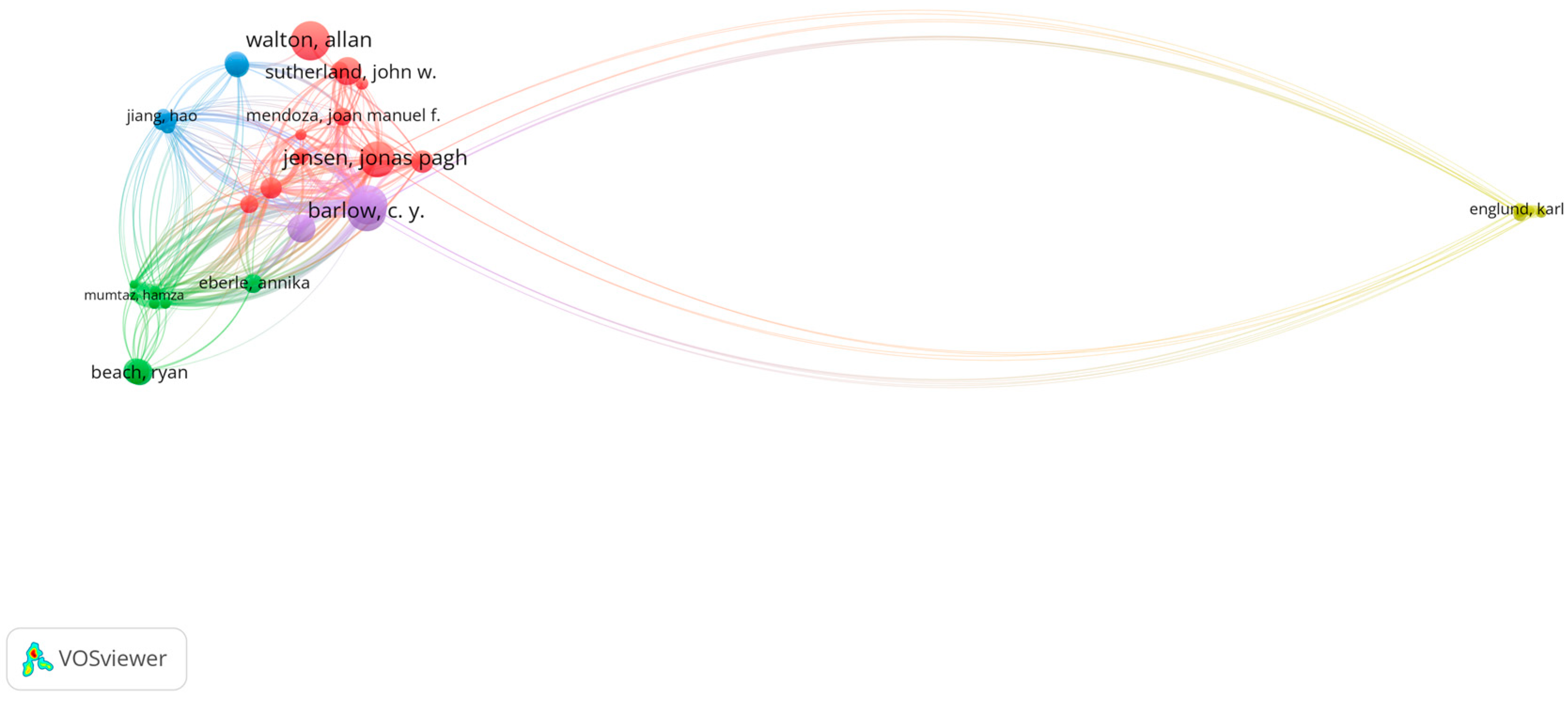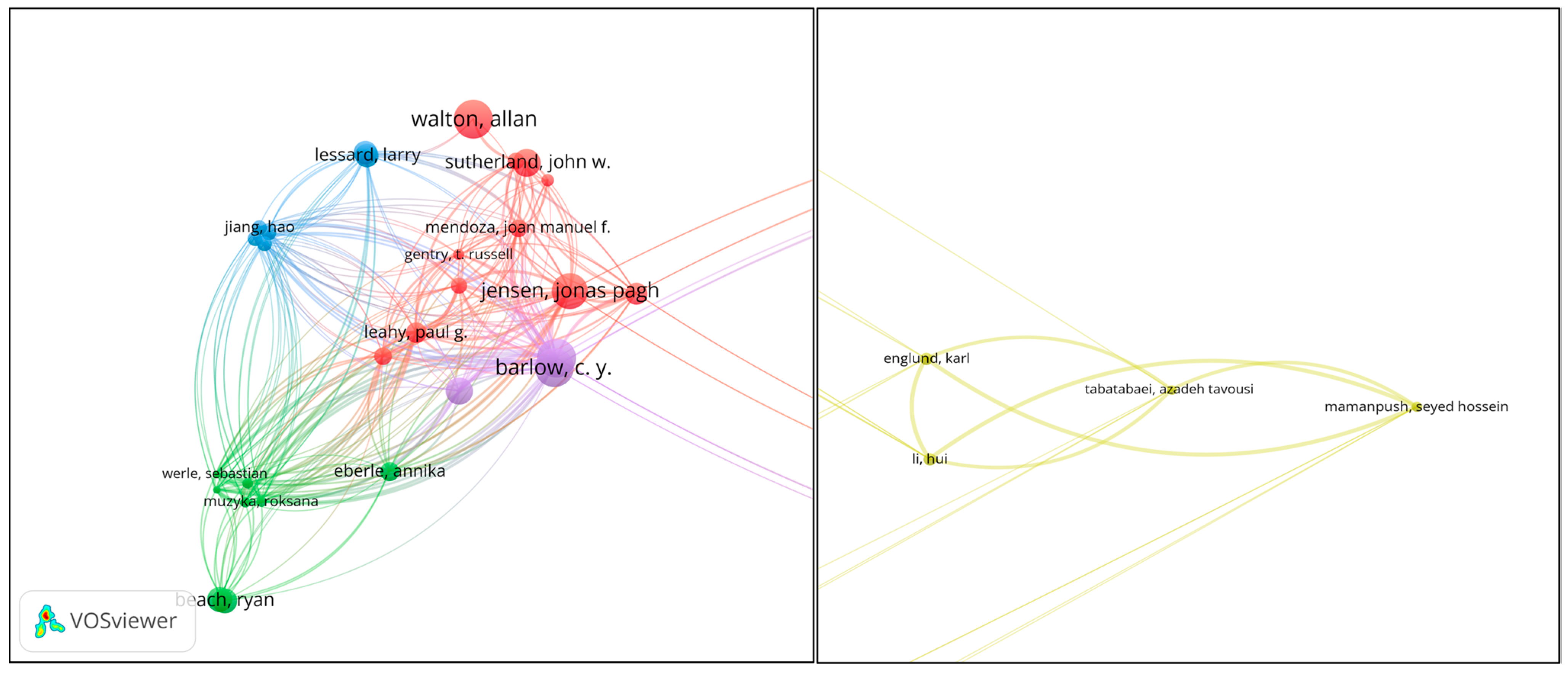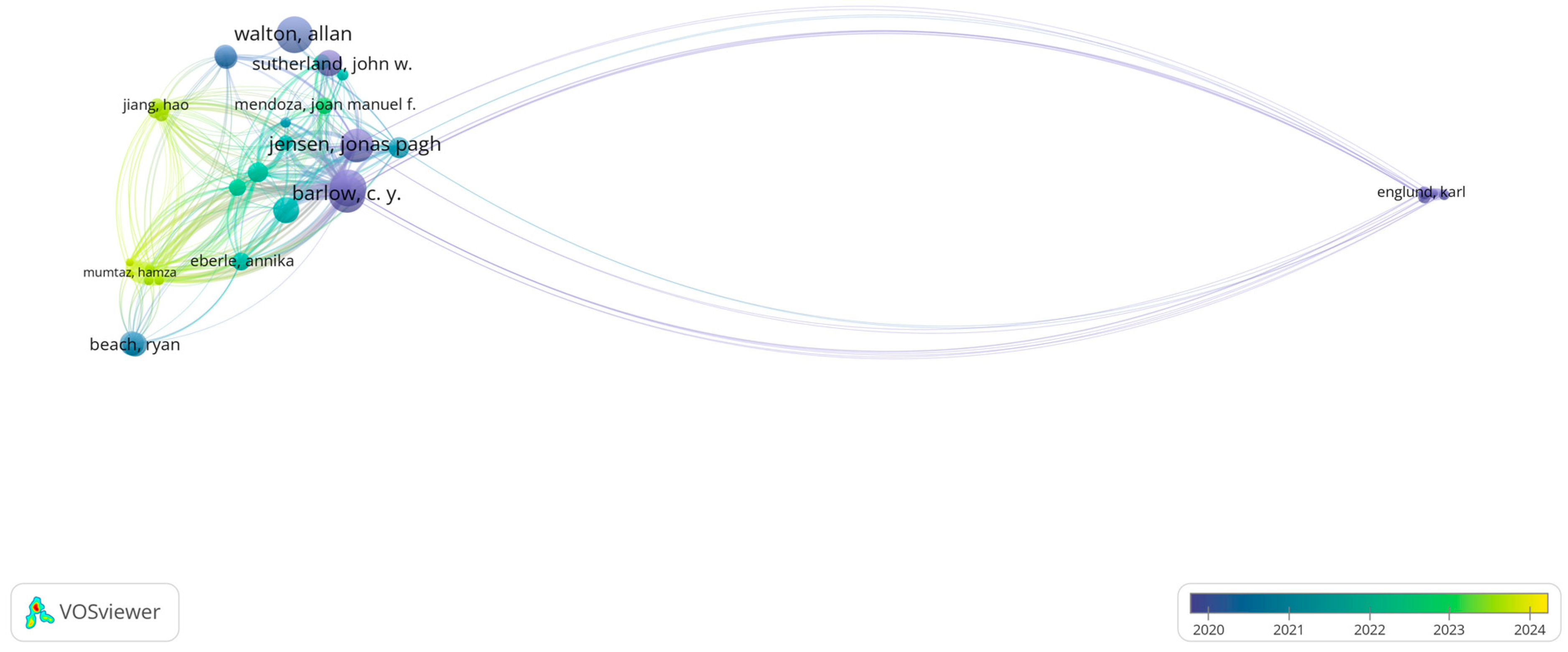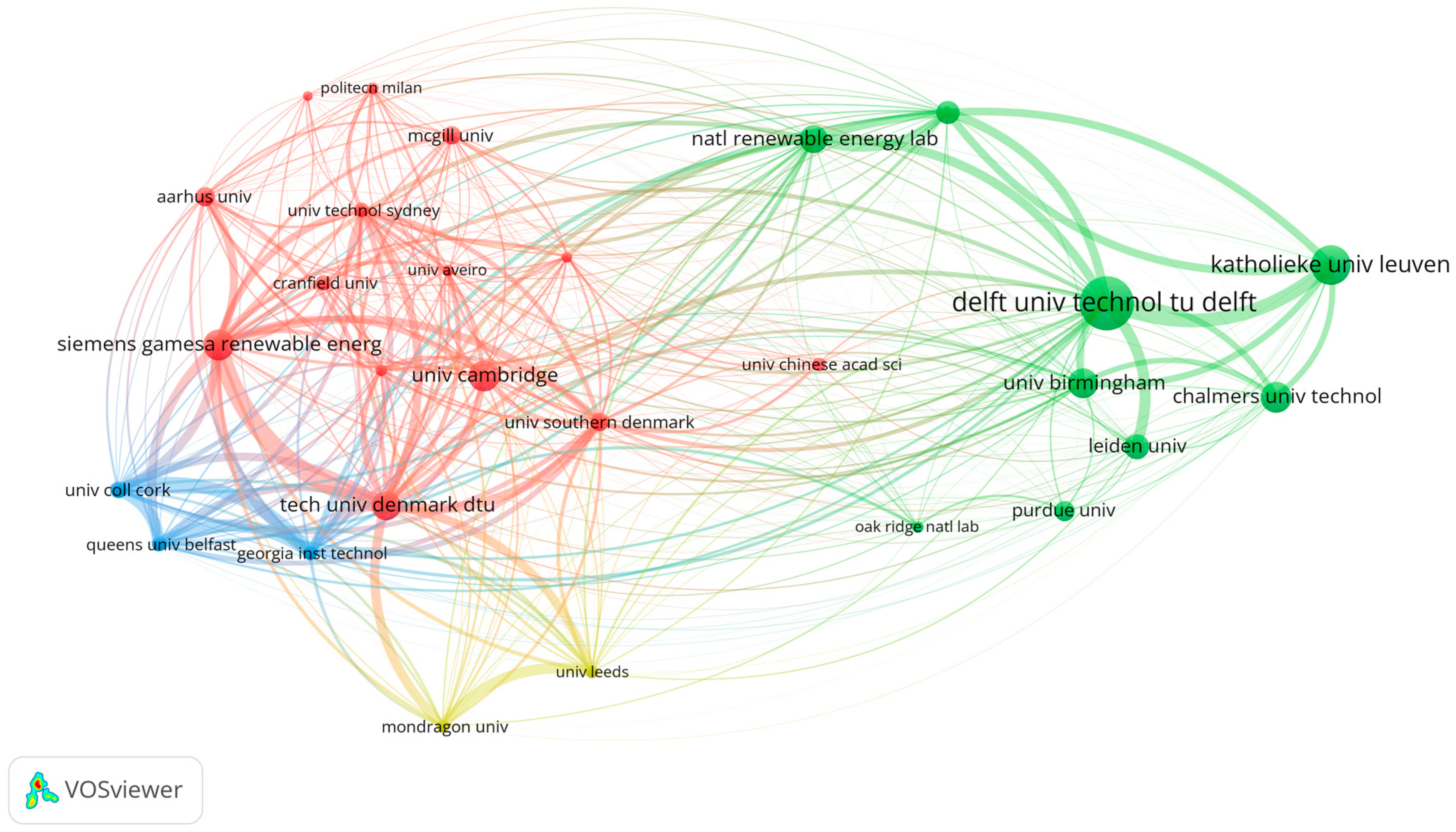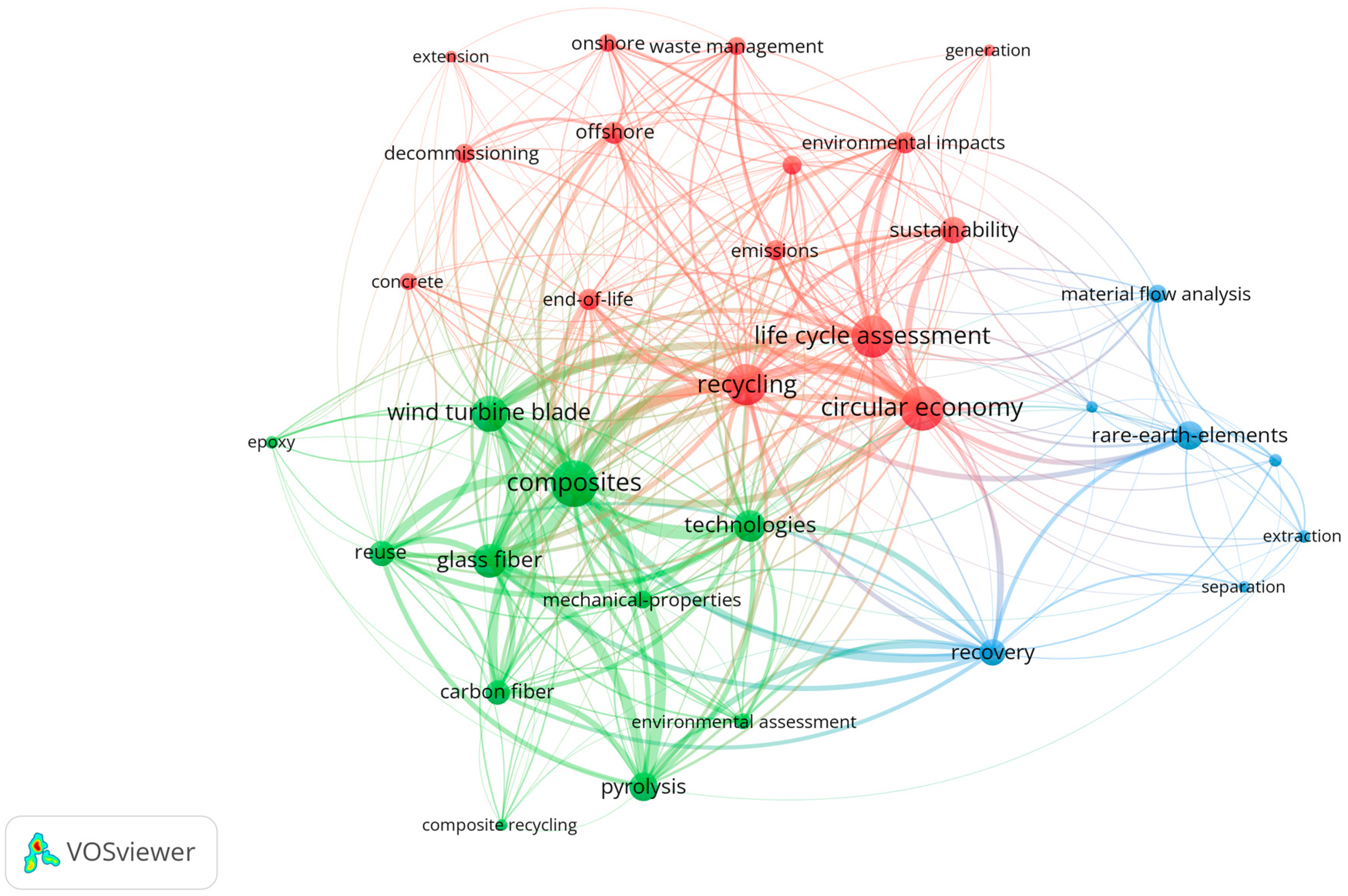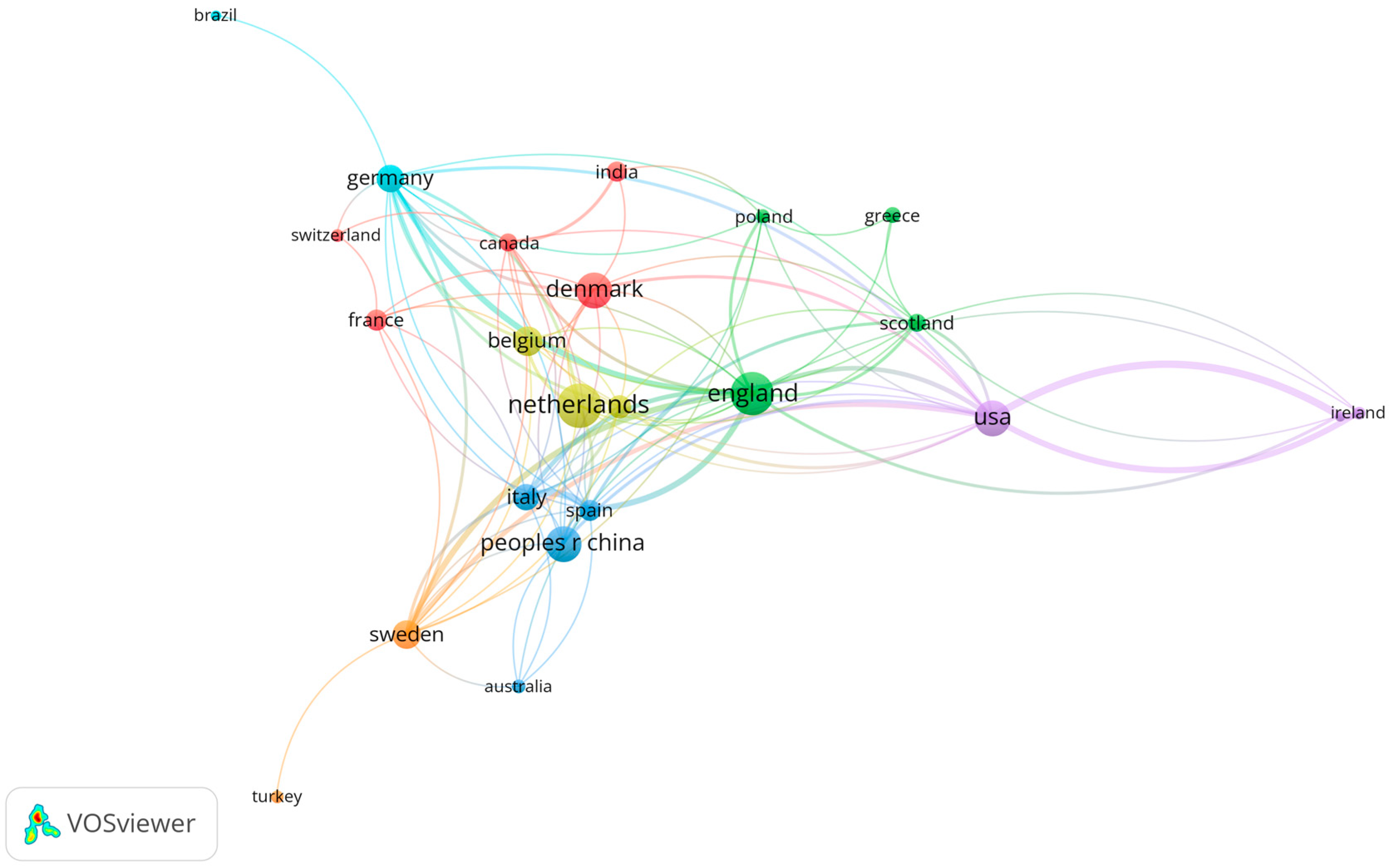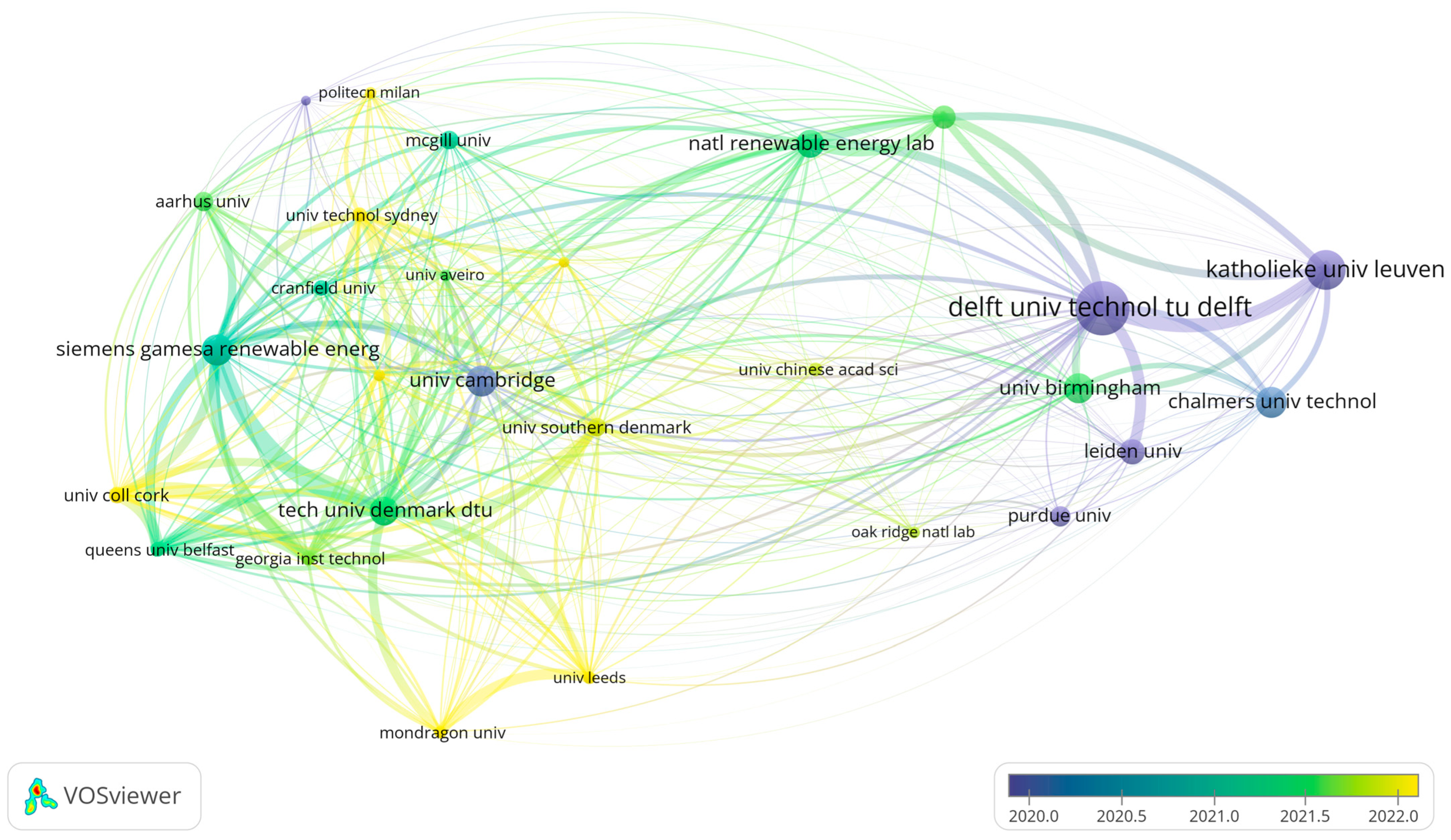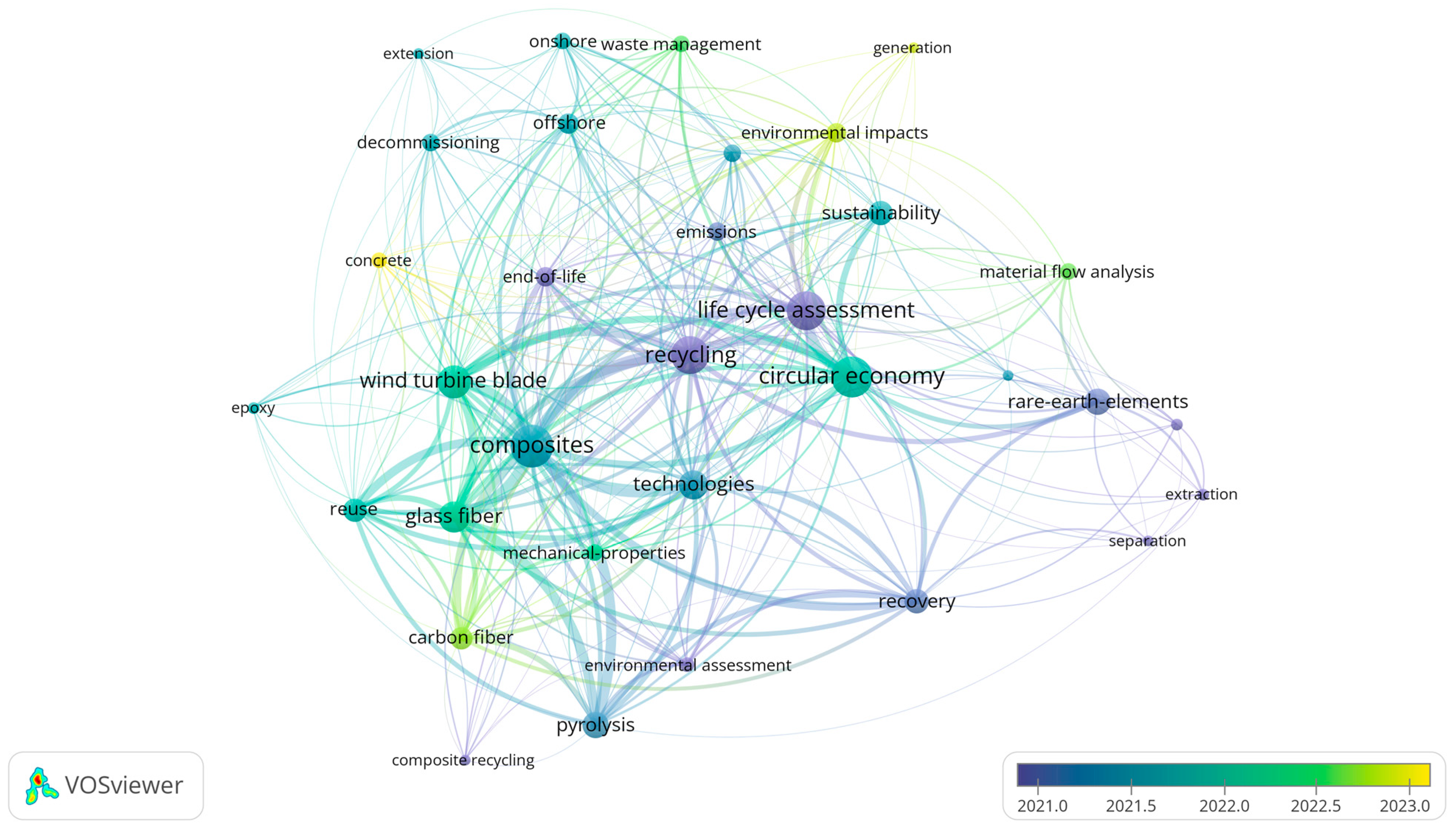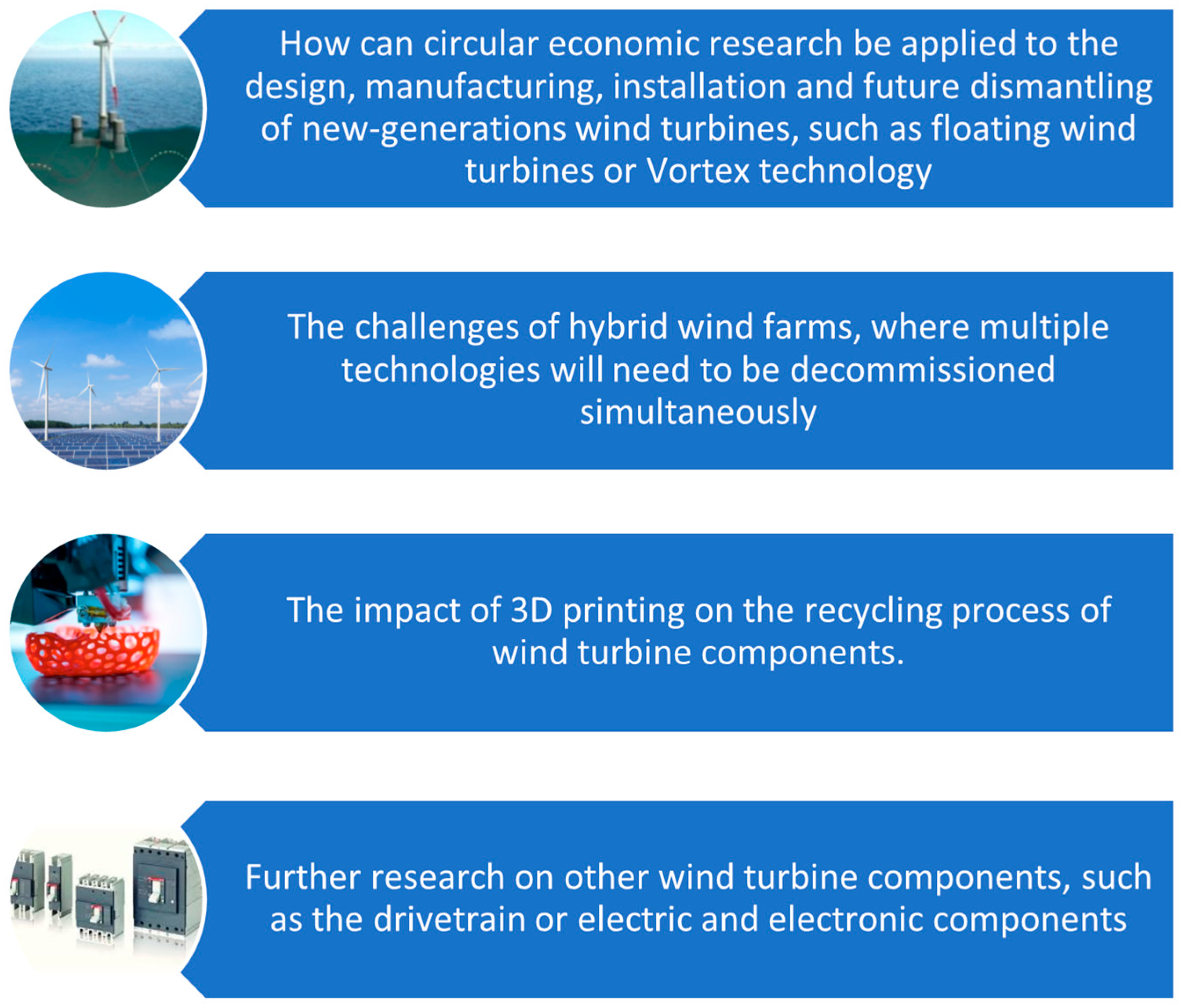1. Introduction
A circular economy (CE) is an alternative to a linear economy (influence, use, disposal) in which assets are kept in use for as long as possible. It aims to extract the maximum value from them while they are in use and then recover and regenerate products and materials at the end of their service life [
1]. Therefore, the circular economy (CE) is designed precisely to defend the viability of developing economic and environmental well-being together [
2]. Although the circular economy is applied across various economic sectors, it is particularly crucial in industries where circular principles are essential components of a broader transformation towards climate neutrality and long-term competitiveness. The CE delivers substantial material savings throughout value chains and production processes, generates extra value, and unlocks economic opportunities [
3]. Consequently, efforts to redesign products, manufacturing processes, installations, and services, as well as incorporating renewable energy sources, represent a significant challenge. Among other sectors, the circular economy is being studied and applied in the wind energy sector, which is crucial for the energy transition [
4]. In recent decades, global, installed wind energy capacity has grown from 7.5 GW in 1997 [
5] to 1047 GW in 2023, generating 10% of global electricity [
6], adding 113 GW of new capacity in 2024 alone, growing by 11.1% compared to the previous year [
7], and contributing to the outcome of the First Global Stocktake at COP28 which called on all parties to triple renewable power and double energy efficiency by 2030, providing new momentum to the global energy transition [
8]. Amongst the top ten countries, Brazil with 20,8% and China with 19,0% have the highest growth rates [
6]. The EU currently has 285 GW of installed wind capacity: 248 GW onshore and 37 GW offshore, representing 19% of electricity production, with the expectation to install 187 GW of new wind power capacity in the 2025–2030 period [
9]. Wind turbines (WTs) have an expected design lifetime of 20 to 25 years, after which decommissioning (i.e., shutting them down, dismantling, and removing them) is expected [
10]. Very likely, newer wind farms constructed with more modern turbines will have a longer lifespan [
9]. Although repowering or modifying machines can extend their useful life, it is expected by 2026 more than 1600 WTs will be dismantled per year partially or totally [
11]. In the case of Europe, it is expected about 22 GW to be decommissioned over the 2025–2030 period [
9]. Consequently, an increase in waste material from discarded WTs is anticipated [
12].
Although WTs have historically not been designed for reuse and efficient end-of-life management, it is estimated that their recycling rate, excluding the foundation, ranges between 80% and 90% [
5]. Components such as metal parts, mechanical components, blades, and foundations are components that can be reused, recycled, or converted. Ramos et al. [
13] identified three main options for these assets: (i) extend their operational life beyond their nominal expected lifetime by estimating their remaining life and potentially replacing some components; (ii) replace the WTs with more recent technology and with higher efficiency, in a process usually designated as repowering; or (iii) completely dismantle the wind farm. Any of these alternatives involves discarding materials, especially the decommissioning process. In addition, the end-of-life economic cost is a major barrier for the circular and sustainable management of the waste streams [
14]. According to Ortegon et al., the decommissioning cost is about 75% of the total installation costs [
15].
The first significant studies on wind turbine component recycling emerged in the early 2000s, focusing mainly on the end-of-life stage. For instance, Borup and Andersen [
16] described a method for reducing the negative environmental impacts of WTs and analyzed the future removal and recycling processes for offshore WTs. Similarly, Martínez et al. [
17] focused on determining and quantifying the related emissions and the impact of wind energy production technology. In short, these studies, along with others from subsequent years, have primarily examined wind turbine components with a substantial environmental impact or high economic value. In parallel with research produced during the studied period, industry guides began outlining best practices for wind turbine dismantling [
18], and legislation such as the Directive [
19] was introduced to define the basic concepts related to waste management. While the dismantling of WTs and the management of special waste resources are regulated by national legislation, there is still no industrial framework or standardized legislation for the circular management of wind farms at the end of their life. This lack of standardization makes it difficult to estimate costs and identify opportunities for implementing circular economy principles [
20].
In Spain, one of the world’s leading wind energy producers, 7500 wind generators have exceeded 20 years of useful life. As a result, in the coming years, these wind farms must choose between life extension, repowering, or decommissioning [
21]. However, there is no established regulatory framework for decommissioning, although some requirements are included in the Environmental Impact Assessment (EIA) for each project. Currently, the circular economy is already present in the Spanish wind energy sector with companies such as EnergyLoop and Renercycle dedicated to circular economy initiatives in wind energy. These companies, in collaboration with wind industry partners, offer services such as wind farm decommissioning, reconditioning, recovery, and recycling. However, current reverse logistic systems are limited to just particular, easy-to-handle or high-valued components [
14] or those with an important environmental impact.
As a result, the application of the circular economy has gained importance, given the increasing volume of waste expected in the coming years and the economic and environmental challenges that must be addressed. With the widespread installation of wind farms globally and the promotion of renewable energy by various countries, this topic has worldwide relevance. In this context, a quick search in the major research databases reveals hundreds of studies related to circular economy in WTs. Some of these studies have taken a global perspective on circularity, while others have focused more specifically on selected wind turbine components. A brief analysis of the recent publications highlights key areas of ongoing research. For example, Gast et al. [
11] suggested opportunities for improving resource management in the transition to a circular economy through enhanced component reuse and recycling. Alavi et al. [
12] provides an overview of current and future wind turbine waste using material flow analysis (MFA) across five national wind energy deployment scenarios, considering various wind turbine technologies. Kramer et al. [
22] studied the economic viability of blade recycling in Denmark and Germany, improving the decision-making basis for policymakers and companies aiming for sustainable resource throughout the wind industry value chain. Techniques such as Life Cycle Analysis (LCA) and Data Envelopment Analysis (DEA) have been employed to evaluate the efficiency of different end-of-life (EOL) treatment methods for decommissioned turbines [
5]. It should also be noted that Jensen [
10] observed that experience with onshore wind decommissioning is more advanced than with offshore projects, as the uncertainties, risks, and costs associated with offshore decommissioning are significantly higher.
A systematic literature review does not appear to be suitable for detecting the trends, identifying key authors, mapping collaborating networks, uncovering research gaps, and highlighting potential future contributions in the field. Handling large volumes of scientific data—such as authors, citations, publications, occurrences, keywords, and topics—becomes complex and inefficient when attempting to summarize and synthesize the existing literature in this domain. Therefore, this paper proposes a bibliometric analysis, as detailed in the next section, to provide an up-to-date perspective on the circular economy in WTs. Bibliometric analysis enables the identification of major trends, collaboration patterns, and key research constituents, as well as the exploration of the intellectual structure of a specific domain within the existing literature [
23]. It facilitates the summarization of large datasets and the mapping of relationships among research actors. In simple terms, bibliometric analysis is the statistical assessment of articles, journals, books, and other scholarly outputs, with the aim of mapping the emergence of new interdisciplinary fields, identifying national and global research networks, and evaluating the productivity of individuals, research teams, institutions, and countries [
24].
Eligüzel and Özceylan [
25] conducted a bibliometric analysis to assess the state of the art and identify gaps in the literature related to end-of-life WTs. Their study analyzed 530 publications from the Scopus database up to January 2022, summarizing total publications, journal production, co-authorship patterns, and examining the literature based on clusters. The main conclusions of the study were as follows: (i) offshore WTs are the primary focus of most studies; (ii) wind turbine blades received the most attention due to their challenging recycling process and complex material properties; and (iii) areas such as logistics, supply chain, onshore (WTs), and the role of technological advances, regulatory measures, and incentives in renewable energy investment and output all require further investigation.
3. Materials and Methods
To provide a comprehensive view of circular economic research in wind energy, systematic data collection is essential.
Figure 1 summarizes the methodological framework. The bibliometric analysis covers a 15-year period (2009–2024) from the first relevant document published in the field to the most recent articles that reflect growing interest in wind farm waste management, driven by the increasing number of wind generators reaching the end of their life cycle. Although documents related to the circular economy begun to appear in the 1990s, the recent years are considered more representative of the current state of the art. This evolution is attributed to the increased interest in green energy, technological advances in the wind sector, global wind farm installations, evolving government regulations, growth in circular economy research, and development and the emergence of new manufacturers, institutions, and foundations. Another reason for focusing on recent years is the absence of bibliometric studies since 2022, despite the availability of essential information to define a reliable state of the art. To ensure a robust bibliometric analysis, the two most widely used and recognized databases—Web of Science (WoS) and Scopus—were selected for data collection. The query was first conducted in WoS and then replicated in Scopus using the same methodological criteria. The aim of using both databases was to cross-validate the results and evaluate the consistency of the retrieved data.
The retrieved data was obtained by leveraging the report analytical capabilities of both databases. The same search strategy was applied to each, and it was observed that the analytical features of the results were similar. The files were downloaded in CSV format, stored in OneDrive, and linked to an Excel file to allow for automatic updates in case a new query was required. The Excel file also enabled filtering and more detailed examination of the data when necessary. Additionally, database notifications were activated in both WoS and Scopus to track newly published studies relevant to this research.
The documents selected for this study included articles, review articles, proceeding papers, book chapters, data papers, and early access publications, as all of them are representative of research activity in this field. Other document types were not considered, as they are typically associated with preliminary research and may contain information that is not yet fully validated.
Bibliometric analysis techniques are typically categorized into two main approaches: (1) performance analysis and (2) science mapping [
23]. Performance analysis evaluates the contributions of various research constituents in the field while science mapping focuses on analyzing the relationships among these constituents. To enhance the effectiveness of these techniques, network visualization software was employed to analyze and illustrate interconnectedness among researcher entities, identify key nodes, and detect collaborative networks.
In terms of performance analysis, total publications per year, total article citations, and contributions from top journals were selected as key evaluation metrics. These indicators provide a detailed view of research productivity, highlight influential articles, and identify the main journals where fundamental research is published. For science mapping, citation analysis, bibliography coupling, and co-word analysis were applied to examine authorship, institutions, co-occurrence of terms, and country-level contributions, respectively. In addition, Scimago Journal Ranking was used to compare and assess journal impact. For network visualization, VOS viewer (version 1.6.20) was chosen due to its open-source nature software, robust feature set, and flexibility in generating detailed network maps.
During the VOS viewer visualization process, duplications in authors, keywords, and institutions were detected, significantly affecting the accuracy of the extracted data. To address this issue, a thesaurus file was developed by reviewing the data files obtained from the submissions and manually identifying and including all detected duplications. This thesaurus file was then systematically applied in subsequent analyses. Concerning keyword selections, for the query, a preliminary literature review provided an overview of the most frequently used and significant terms related to the study’s theme. The terms “wind turbine” and “windfarm” were identified as key, appearing consistently in all analyzed documents. These were combined with other terms relevant for a focused search, such as “circular economy”, “waste”, “recycl*” (for material management), as well as “decommissioning”, “repowering”, and “end of life” (to address the final stages of asset lifespan). Finally, the precise keyword search string was defined using four Boolean expressions: (1) “circular economy” AND (“wind turbine” OR “wind farms”), (2) “decommissioning” AND (“wind turbine” OR “wind farms”) AND (“waste*” OR “recycl*”), (3) “repowering” AND (“wind turbine*” OR “wind farms”) AND (“waste*” OR “recycl*”), and (4) “end of life” AND (“wind turbine*” OR “wind farms”) AND (“waste*” OR “recycl*”). The search was conducted within article titles, abstracts, and keywords.
In short, using this combination of words ensured the inclusion of documents related to recycling, recovering, and material reuse, covering various end-of-life alternatives for wind generators.
In this study, not only were documents specifically focused on wind generators considered, but also those addressing the wind sector as part of broader discussions. For instance, documents concerning rare earth waste management were included if they referenced applications across multiple industries, including wind energy. This approach helped ensure that relevant information was not omitted.
5. Discussion
5.1. Temporal Publication Trend
Observing the temporal publication trend, two distinct periods can be identified: 2009–2018, during which publication rates remained steady, and 2018–2024, characterized by exponential growth—except for a brief impasse in 2020, likely attributable to the COVID-19 pandemic, which was quickly overcome in 2021. This trend reflects a growing interest among researchers in accelerating developments within the field. We believe this surge responds to the urgent need to address the end-of-life management of numerous WTs installed worldwide, prompting the proposal of various alternatives and scenarios for handling the resulting waste.
Furthermore, the increasing number of publications—expanding at an unprecedented rate—justifies the relevance of conducting a bibliometric study that includes the most recent years. The evidence found substantiates both the necessity and the scholarly value of undertaking an updated bibliometric analysis encompassing this period
5.2. Most Cited Articles
The most cited articles have remained relevant over the years, demonstrating that they have been a focal point since the early studies on the circular economy in wind energy. They also confirm that the waste management of these materials continues to be a major challenge for the industry particularly for blades, due to the high volume of waste and the difficulty of recycling them, and secondly for rare earth elements, due to their high value and limited availability.
It is worth mentioning that not all of the documents specifically focus on the wind energy sector, even though WTs are considered one of the key areas where waste studies are applied. In fact, the three most cited articles refer to specific materials, mentioning their application across various sectors. However, it is important to highlight that the first article specifically focused on wind turbine blade waste—Liu and Barlow [
33]—only appears in the fourth position in the ranking.
Nevertheless, it should be noted that among the top 10 documents, despite references to various wind turbine materials, there are no studies specifically focused on materials such as concrete, low-carbon steel, electronics, or copper, which are also included in WTs and are potentially recyclable.
5.3. Analysis of Journals
It is observed that 10 of the top 12 journals are related to environmental sustainability and waste management, covering a wide range of sectors and grounding their applicability in these areas. In contrast, two journals—Polymers and ACS Sustainable Chemistry & Engineering—are specialized in chemistry and materials science. The articles retrieved from these journals primarily address fibers, composites, and rare earth elements, with a focus on fundamental exploratory research.
5.4. Authorship Analysis
In this authorship analysis, we will focus on highlighting the most relevant findings observed from the analysis of the four different clusters
The first cluster identified is the red one, due to the intensity of relationships among the authors and their research output. In this cluster, Walton, A. is the most cited author, and the paper by Yang et al. [
28] is identified as the highest-cited publication in Web of Science. In relation to the red cluster, Walton’s research focuses on the recovery of critical metals, primarily within green and sustainable technologies. His work proposes recycling methods aimed at achieving complete material digestion and discusses the limitations and future directions in the field. However, a strong collaboration network is not observed around this author, except with Sutherland, J., whose research also centers on permanent magnets from renewable energy systems
On the other hand, (Liu, P., and Barlow, C.Y.), have a similar citation count (400) and are closely positioned in the network, as they have co-authored multiple papers on wind turbine blade waste-management from both environmental and economic perspectives. Their paper [
33] is one of the most cited publications in the field and has become a reference for blade waste management. Within the network structure, these two authors form a key connection with other researchers, such as (Meng, F., Jensen, J., and Beauson, J.), who also focus on blade recycling, including waste prediction, legislation, transformation process, potential application, and circular economy business models.
The red cluster demonstrates strong collaboration; however, the overlay visualization shown in
Figure 5, which provides a temporal perspective, suggests that their recent activity is not as high as that of other authors.
On the other hand, the green cluster is identified, which includes authors such as (Muzyka, R., Sajdak, M., and Sobek, S.), who show lower research output intensity. These authors have co-authored several recent articles addressing specific treatment methods for processing blade waste, such as small molecule-assisted dissolution, oxidative liquefaction, and solvolysis—methods designed to replace traditional disposal techniques like landfilling and incineration. Other researchers in this cluster, including Murray, R. and Beach, Ryan, have focused on developing new materials to enhance the circularity of blade waste
Another identifiable cluster is the blue cluster, which includes (Jiang, H. and Wu, Ya-Chang), who focus on another key technology—pyrolysis. They have published recent studies aimed at improving traditional processes for recovering high-quality fibers from end-of-life WTs. Similarly, Lessard and Rahimizadeh have recently investigated the use of recycled short glass fibers in the fused filament fabrication (FFF) process—a widely used 3D-printing technique for manufacturing thermoplastic parts due to its low cost and minimal material waste [
34]—with the aim of enhancing the mechanical performance of 3D-printed components [
35]. The integration of this cutting-edge technology with fiber recycling derived from wind turbine blade waste represents a promising and increasingly relevant area of research in the field.
Additionally, an isolated cluster in terms of citations was identified, focusing on composite recycling but specifically on the properties of recycled products. This cluster includes (Englund, K., Li, H., Tabatabaei, A., Mamanpush, S.), who have co-authored five articles. They are connected to the red cluster due to thematic similarities in fibers recycling, and their research output has not been prolific in recent years.
In summary, wind turbine blade waste management remains the primary concern in the circular economy for WTs. The research into specific techniques for processing composite materials, such as pyrolysis, is emerging, alongside efforts to develop new materials that facilitate blade recycling. Finally, while the recovery of critical metals from wind turbine components was once a significant research focus, recent trends suggest a decline in this field.
5.5. Institutional and Organization Analysis
In this institutional and organization analysis, we will focus on highlighting the most relevant findings observed from the analysis of the four different clusters
First, a strong research network in terms of bibliographic coupling can be observed, with (Siemens Gamesa Renewable), the (Technical University of Denmark DTU), and (University of Cambridge) forming the main node of the red cluster. These institutions exhibit strong links between themselves and with other institutions, demonstrating intense cooperation and collaboration in similar fields. Notably, researchers such as (Jensen P, and Beauson, J) are affiliated with these institutions. A closer look at the documents within this cluster confirms that their research primarily focuses on blade recycling.
It is worth noting that the presence of Siemens Gamesa Renewable Energy (Zamudio, Spain) as a key institution highlights the involvement of manufacturers in the circular economy, particularly in addressing blade waste, which has significant environmental and social impacts. This company developed the world’s first recyclable wind turbine blade and, from a sustainability perspective, aims to deliver a fully recyclable turbine by 2040 [
36].
Moreover, this group has a clear geographic component, with Denmark serving as the central hub for institutions within this cluster. This is a consequence of Denmark’s pioneering role in the wind industry, where major manufacturers have facilities and various institutions conduct research in wind power. This development was reinforced by government legislation where an integrative public leadership approach, involving a combination of supportive institutional designs and policy instruments, along with unexpected bottom-up pressure for alternatives to nuclear power, fostered innovation and production of WTs as early as the 1970s and binding climate legislation in the summer of 2020 aimed at cutting 70% of CO
2 emissions before 2030 [
37].
On the other hand, the green cluster is led by (Delft University of Technology), which ranks as the most cited institution and is closely connected to (Katholieke Universiteit Leuven) and (University of Birmingham). Although this cluster exhibits strong internal links, it is considerably separated into the red cluster in terms of bibliographic coupling. This is likely because the research themes in the green cluster extend beyond blades to include rare earth materials, safety and health concerns related to dismantling WTs, and photovoltaic decommissioning.
Notably, the (University of the Chinese Academy of Sciences) and the (National Renewable Energy Laboratory) maintain connections with both the red and the green cluster, indicating that their research overlaps with both groups.
Examining the overlay map shown in
Figure 9, the red cluster exhibits strong relationships, and its documents are relatively recent. This suggests that the institutions in this cluster have growing relevance or recent activity in the field. In contrast, (Delft University of Technology) and most institutions in the green cluster appear to be decreasing in relevance. The blue cluster, composed of institutions such as (Georgia Institute of Technology), (Queen’s University Belfast), and (University College Cork), has been studying applications derived from fibers produced through blade recycling. These institutions maintain strong connections with the most relevant organizations in terms of citations.
Additionally, new institutions have emerged in recent years (yellow cluster), such as (Mondragon University) and (University of Leeds). The research from these institutions frequently includes the term “circular economy” and explores circular business models (CBM) that optimize resource efficiency and sustainability performance.
5.6. Keyword Analysis
In this keyword analysis, we will focus on highlighting the most relevant findings observed from the analysis of the three different clusters.
The first cluster (red) is centered around “circular economy” and “life cycle assessment”, reflecting the application of LCA in determining the performance of CE practices in the wind energy, particularly in recycling materials from WTs. These terms are commonly used with others related to the circular economy, such as “environmental impact”, “emissions”, and “waste management”, as well as end-of-life product consideration like “decommissioning” and “end-of life”. This indicates that a significant body of research has been published on CE applications, both for onshore and offshore wind energy. However, the overlay map shown in
Figure 10 suggests that LCA is becoming less prominent in the recent literature, with research shifting towards “circular economy”, “waste management”, and “material flow analysis”. This trend implies that LCA is already a well-established methodology in the industry, and the current research is focusing more on waste management strategies for wind turbine components. Additionally, despite Bilgili and Alphan [
38] stating that offshore WTs are the focus of studies, the term “onshore” continues to appear in the retrieved documents, though less frequently.
The second cluster (green) is clearly led by “composites”, demonstrating the main concern in wind turbine blade materials. This term frequently appears alongside its primary materials, “glass fiber” and “carbon fiber”, as these are key materials recovered in the recycling processes. The keyword “technologies” indicates a focus on recycling and recovery processes, with pyrolysis standing out as particularly promising method for material recovery from blades and other composite-based components. Other related terms, such as “concrete”, suggest studies on potential applications for recycled materials, such as using them as concrete filler—an emerging trend in the field. Furthermore, the term “mechanical properties” appears as a growing research interest, indicating a focus on improving the properties of recycled materials. The overlay map confirms that “composites” and “glass fiber” remain dominant keywords, followed by “pyrolysis” and the “recycled products” such as glass fiber and carbon fiber. Notably, while carbon fiber is used in significantly smaller quantities than glass fiber, its high economic value and superior properties continue to drive research interest.
The third cluster (blue), as previously discussed in other sections, focuses on recovering and reusing rare metals. This is supported by terms as “rare-earth metals”, “separation”, and “extraction” The overlap map suggests that this research area is no longer a major trend in the recent literature, likely due to extensive prior work in the field, as concluded in
Section 4.4. Nonetheless, it demonstrates that interest in this area remains crucial, particularly in addressing the vulnerabilities associated with rare earth elements (REEs) and in proposing sustainable recovery processes. To better understand the evolution of occurrences,
Figure 11 presents a timeline of the average publication year, along with the number of occurrences throughout the study period. Additionally,
Table 3 displays the occurrences divided into two distinct periods: 2009–2016 and 2017–2024.
To further analyze the keywords trends and identify future knowledge gaps, data from the Scopus database was also considered. The number of articles retrieved from Scopus (379) was higher than from Web of Science (296), as Scopus indexes a broader range of journals, conference papers, and books, including regional publications and open access journals. Additionally, Scopus is considered to be more frequently updated and offers faster indexing of new content. The same methodology was applied, and the results were generally similar, with two notable key works emerging in the recent literature. The first one is “supply chain”, indicating an increasing focus on recovery and reverse logistics processes in the wind energy supply chain. This suggests that the gap identified by Eligüzel and Özceylan [
25], regarding the lack of research on logistics and supply chains operations, is now being addressed. The second one is “economic aspects”, emphasizing the importance of providing economic incentives for establishing a circular economy in wind energy sector. This research considers factors such as quantities and locations of waste streams and material flows.
5.7. Countries
First, we identified a strong collaboration among Western European countries—particularly Denmark, the Netherlands, and England—which are positioned at the center of a network and connected to various other countries. As mentioned in
Section 4.4, most of the leading institutions in this field are based in Europe, largely due to the region’s pioneering role in wind energy. Additionally, the age distribution of onshore wind capacity in Europe is likely to stimulate further research in this area.
England appears at the center of the network, fostering collaboration between the major European institutions and the United States. This is further reinforced by England’s high citations and number of published documents.
Another significant cluster is formed by the United States and Ireland, which exhibit strong collaboration, co-authoring several studies on end-of life alternatives for wind turbine blades.
A particularly noteworthy result is the case of China, which stands out in terms of citation, collaborations, and recent research activity. This is likely due to China’s exceptional role in driving global wind power development—according to estimates, the country added 79.37 Gigawatt in 2023 [
6].
Considering the overlay map in
Figure 12, while the Netherlands (Delft University of Technology), Belgium, and France show relatively lower activity, there is a clear trend towards decentralization in the field. The research activity is increasingly shifting toward China, the United States, India, Italy, and Spain. This trend is further confirmed by the number of publications per country
6. Conclusions
This study shows that the literature on the circular economy has grown rapidly in recent years, reflecting increasing concerns about the industry challenges, particularly as forecasts suggest that a growing number of WTs will soon reach the end of their operational life. As outlined, most of the documents focus on rare earth elements (REEs) and blade recycling. In the case of REEs, they are a key topic due to their high economic value and the sensitivity of their supply chain. Blade recycling, on the other hand, is a major research area because the materials used in blades are non-biodegradable. The research on REEs has shown a declining trend, likely indicating that the topic is either mature and well developed across various industries or has been overshadowed by emerging topics in terms of output and citations. Nevertheless, this does not mean the topic is no longer being studied; on the contrary, it remains crucial to the field. Permanent magnets, which rely on REEs, are increasingly used not only in WTs but also in other cutting-edge technologies, as evidenced by the 2024 publications exploring new processes for REE recovery.
Furthermore, studies focusing on specific processes to obtain recycled products with enhanced properties are opening new opportunities for optimization, not only from a technological perspective but also from an economic standpoint. Regarding blade recycling, pyrolysis has been firmly established as a key process, with current efforts aimed at reducing emissions, lowering energy consumption, and improving the quality of the recycled material. For instance, the recovered fibers are being reused in new composite products, significantly enhancing the sustainability of composite structures.
Nonetheless, the emerging research trends are increasingly focusing on supply chain and logistics, indicating that a knowledge gap remains concerning the full value chain. As awareness grows around the potential for reusing, recovering, and recycling wind turbine (WT) components, the associated challenges in logistics and supply chain management must be proactively addressed. Several key factors must be analyzed to manage these materials effectively, including the location of wind farms, the presence of companies specializing in repowering or decommissioning, the availability of a logistics infrastructure and sorting facilities, relevant policies, and the economic incentives supporting reverse logistics. Therefore, an efficient CE in the wind energy sector will not be feasible unless the material loop is optimized. This includes improving material-handling processes such as collection, transportation to dedicated hubs for storage and sorting, and subsequent processing in treatment plants.
Another growing area of interest is the use of recycled fibers in 3D-printing technologies to enhance material properties, combining innovative manufacturing methods with circular economy principles in wind turbine applications. This application is strongly influenced by the fiber recovery process, not only in terms of economic feasibility—which makes this strategy attractive—but also in relation to the quality of the short fibers obtained. However, while some studies have provided conclusive data regarding the quality of the resulting fibers, no economic analyses have been presented to date.
Regarding authors and institutions, strong collaborative ties have been established among European researchers and institutions, positioning them as leaders in the field. This is further confirmed by the co-authorship and country-level collaboration analyses. However, the trend is shifting towards other countries, particularly China, which holds a strong position in the wind energy market.
Concerning countries, regional research imbalances have been identified, with notably limited research in India and Japan. This is surprising given that India added 3.1 GW of wind capacity in 2023, maintaining its position as the fifth-largest market for new installations, while Japan added 5.2 GW in the same year [
6]. This lack of research may stem from a stronger focus on the rapid deployment of renewable energy infrastructure, rather than on end-of-life strategies or sustainable materials management. Additionally, policy frameworks and industrial priorities in these countries may not yet fully support circular economy principles in the wind energy sector.
On the other hand, despite China and Germany being major hubs for wind energy research, there appears to be a lack of strong collaboration between them. This gap could be addressed through initiatives such as Sino-German cooperation, exemplified by joint patents like the one between Goldwind Science and Technology and Siemens Gamesa Renewable Energy. Finally, several underexplored or underdeveloped research areas remain in the literature, as shown in
Figure 13.
Floating wind energy is still under development, and this technology is expected to further unlock the potential of offshore wind to support the global energy transition [
39]. Recent studies have focused on improving the maintenance and end-of-life phases within LCA frameworks to reduce environmental impacts [
40]. Yildiz et al. [
41] conducted a life-cycle cost analysis for floating offshore WTs, combining the latest data and parametric formulas from databases and the relevant literature. Their cost models emphasize cost minimization, with a particular focus on operation and maintenance (OPEX), decommissioning (DECOM), and levelized cost of energy (LCOE), which are key factors in wind power economics. As this represents a new generation of WTs, existing knowledge of the CE, along with empirical experience in repowering and decommissioning, should be leveraged.
In the context of hybrid wind farms, some publications have addressed issues relating to dismantled photovoltaic installations. For example, Powicki et al. [
42] reviewed publicly available decommissioning plans developed to support the permitting and development of U.S solar photovoltaic plants, while Shrestha and Zaman [
43] focused on identifying a sustainable solution for the management of EoL photovoltaic panel waste. However, given the growing proliferation of hybrid wind farms, it is important to examine how these installations will be dismantled, drawing on knowledge from both the photovoltaic and wind energy sectors. Key aspects to be analyzed include the existing legislation, the definition of specific technical and operational characteristics, the establishment of unified classification standards for decommissioned materials, and the associated supply chain and logistics challenges.
Bladeless wind turbines represent an emerging technology that operates without traditional blades. Instead, they utilize a bluff body mounted on a flexible structure within the flow field [
44] and are based on the principle of vortex-induced vibrations (VIV), where oscillation or vibration caused by wind are harnessed to generate electricity [
45]. Given the promising potential of this technology, circular economy principles—already well established for conventional WTs—should be incorporated from the early design stages. This is particularly important in LCA studies, which should consider factors such as the selection of materials and processes that enable reuse and recycling, modular design to facilitate disassembly at end-of-life, and the integration of existing supply chain and logistics models to enhance sustainability and efficiency.
The authors acknowledge certain limitations of this bibliometric study. Although it was conducted using the Scopus and Web of Science (WoS) databases, both of which are powerful tools, these platforms have inherent constraints. Their selective indexing criteria often favor journals published in English and those from Western countries, potentially leading to the under-representation of regional or non-English-language research. Moreover, they may not include certain types of scholarly outputs such as conference proceedings, books, or the grey literature as comprehensively as other sources like Google Scholar. Nonetheless, this study makes a valuable contribution to the body of knowledge by providing an up-to-date overview of a highly current and evolving topic.
Another limitation of bibliometric mapping lies in the potential bias or incompleteness inherent in the selection of data sources and keywords, which can influence the accuracy and representativeness of the resulting thematic structures. These limitations may lead to an under-representation of certain subfields or emerging topics. To address this concern, we incorporated expert consultation during the keyword selection and thematic interpretation phases to ensure alignment with the conceptual landscape of the field. This qualitative validation helps enhance the credibility and relevance of the bibliometric maps in capturing the dynamics and structure of the research domain.


